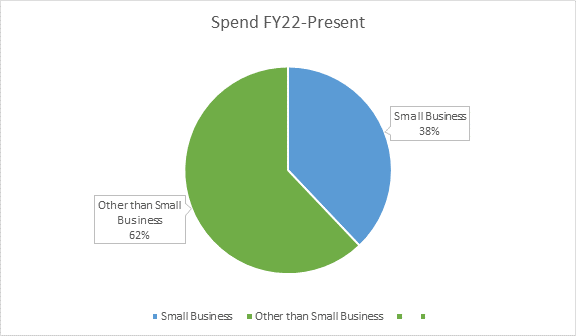Breaking Down GSA Schedule Small Business Sales
GSA Schedule | 8 Min Read
There are plentiful opportunities for companies of all sizes to offer their products/services through a General Services Administration (GSA) Multiple Award Schedule (MAS), including small businesses. Many qualified small businesses benefit greatly from the advantages associated with being a small business in the federal government, but they may not realize the landscape of opportunities available. That’s why it’s important to do some market research to see what’s out there.
Let’s look at some of the numbers from government Fiscal Year (FY) 2023 to present and see how much flowed through small businesses depending on the small business and compare it to Other than Small Businesses (OTSBs). We’ll also dive into each industry to get a better understanding of how much spending was directed to each.
Small Business Sales through the GSA Multiple Award Schedule
First, we used the Schedule Sales Query + (SSQ) tool to find the spending allocated toward small businesses and OTSB across the GSA Schedules program. SSQ+ is a valuable GSA data resource that is great for current or prospective contractors who want to conduct some extra market research about their own industry or potential ones to pursue.
It’s important to note that this data was taken from government FY 2023 so far (which began in October 2022) to present.

As you can see, OTSBs made up for 62% of spending and small businesses made up for 38% of spending. While it’s no surprise that OTSBs are still a higher percentage of sales, small businesses are not too far behind. In the federal market there is plenty of room for all businesses to succeed. GSA strongly encourages small businesses to acquire a contract and opt for one of their various set-asides, which helps eliminate competition and opens doors to more specialized opportunities which we’ll cover below.
Small Business Set-Asides
Now that we’ve seen a view of small business sales overall, it’s time to delve deeper into the set-asides and how much spending is allocated through them. As a small business, you may also qualify for an additional socio-economic status that will grant you further specialized programs and opportunities. We’ll briefly recap them below:
Service-Disabled Veteran-Owned Small Business (SDVOSB)
Stakeholders must have a service-related disability. Read the bullet below to learn another key qualification of a SDVOSB.
Veteran-Owned Small Businesses (VOSB)
Stakeholders of these eligible businesses must be veterans as described in the United States Code and make up 51% of the company.
Women-Owned Small Business (WOSB)
Your small business must be at least 51% owned by women and a woman must hold the highest officer position in the company.
Economically Disadvantaged Women-Owned Small Business (EDWOSB)
Like WOSB, your small business must be at least 51% owned by women but also considered economically disadvantaged.
Small Disadvantaged Business (SDB)
51% of the business must be owned and controlled by U.S. citizen who are disadvantaged economically and socially as defined by 13 Code of Federal Regulations (CFR) 124.
Historically Underutilized Business Zones (HUBZones)
If your small business is within specified regions, you may qualify for the HUBZone Program.
While this is simply a taste of each set-aside, there are a lot more requirements that distinguish these programs from one another. To learn more specifics, visit the U.S. Small Business Administration. Now that you understand a little more about small business set-asides, let’s take a closer look at the sales for each individual set-aside.
GSA Schedule Sales Under Small Business Set Asides
Again, the SSQ+ paints a big picture of differing data trends. Not only can you compare small businesses and other-than small businesses, but you can also see how each individual set-aside contributes to government spending. SDB appears to be where most government buyers spend their money followed by WOSB and VOSB. If you’re wondering whether your business could be considered a small business set-aside, check out our blog on “Do I Qualify for Set- Aside Contracts?”
Here's a breakdown of the spending from FY 2023 so far:
|
Small Business Set-asides |
Spending from FY 2023 so Far (October 2022- May 2023) |
|
Service-Disabled Veteran-Owned Small Business (SDVOSB) |
$1,791,725,727 |
|
Veteran-Owned Small Business (VOSB) |
$2,209,791,174 |
|
Economically Disadvantaged Women-Owned Small Business (EDWOSB) |
$1,330,234,700 |
|
Women-Owned Small Business (WOSB) |
$2,633,424,560 |
|
Small Disadvantaged Business (SDB) 8(a) |
$1,975,677,742 |
|
Small Disadvantaged Business (SDB) |
$3,191,735,102 |
|
Historically Underutilized Business Zones (HUBZones) |
$965,783,742 |
Small Business Sales for Each Industry/Large Category
Earlier we highlighted small business set-asides individually using the SSQ+ tool which displays digestible data for contractors to learn more about each industry and popular areas of spending.
Let’s take a look at how they come together for some of the major industries.
|
Industry |
Sales for FY2023 so Far Under Small Businesses |
|
IT |
$4,269,196,380 |
|
Professional Services |
$2,055,677,594 |
|
Transportation and Logistics Services |
$410,743,533 |
|
Industrial Products & Services |
$652,553,001 |
|
Facilities and Construction |
$442,395,273 |
|
Human Capital |
$321,389,277 |
|
Office Management |
$347,327,461 |
|
Travel and Lodging |
$174,289,037 |
|
Security and Protection |
$128,925,480 |
|
Clothing, Textiles, & Subsistence S&E |
$85,273,663 |
IT and Professional Services are industry leaders for government spending in FY 2022- present. Although these large categories are doing outstandingly well, the other large categories are also winning significant government dollars.
Becoming a Certified Small Business
You can be recognized under various set-asides if you meet the requirements. NAICS codes and size standards help the Small Business Administration (SBA) determine if your company meets the small business criteria. The federal government advocates for small businesses so you can capitalize on opportunities without intense competition.
If you have any questions about becoming a certified small business or need assistance with your GSA Schedule, we are here to help you.






